McMath–Pierce solar telescope
McMath–Pierce solar telescope is a 1.6 m f/54 reflecting solar telescope at Kitt Peak National Observatory in Arizona, United States. Built in 1962, the building was designed by American architect Myron Goldsmith and Bangladesh-Pakistani structural engineer Fazlur Rahman Khan.[1] It is the largest solar telescope and the largest unobstructed aperture telescope in the world. It is named after the astronomers Robert Raynolds McMath and Keith Pierce.
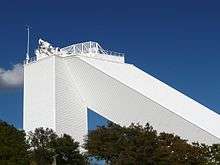 | |
| Alternative names | McMath–Pierce Telescope |
|---|---|
| Named after | Keith Pierce, Robert Raynolds McMath |
| Part of | Kitt Peak National Observatory |
| Location(s) | Arizona |
| Coordinates | 31°57′30″N 111°35′42″W |
| Organization | National Solar Observatory |
| Altitude | 2,096 m (6,877 ft) |
| Observing time | 79 percent |
| Telescope style | reflecting telescope solar telescope |
| Number of telescopes | 3 |
| Diameter | 161 cm (5 ft 3 in) |
| Angular resolution | 0.07 arcsecond |
| Collecting area | 2.04 m2 (22.0 sq ft) |
| Focal length | 87 m (285 ft 5 in) |
| Mounting | Equatorial mount |
| Website | nsokp |
 Location of McMath–Pierce solar telescope | |
It was originally called the McMath Solar Telescope, and then later renamed the McMath-Pierce Solar Telescope in 1992.[2][3] Although it is designed for observation of the Sun, it can also be used to view bright objects at night.[2]
In 2018, the telescope received a 4.5 million USD grant for an enhanced visitor center and other programs, and to overall revitalize the national icon.[4]
Construction
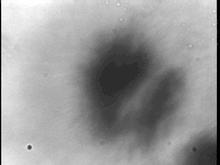
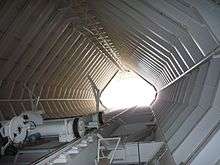
The telescope is a triple instrument. In addition to the primary 1.61 m mirror fed by the 2.03 m heliostat, there are a pair of telescopes fed by 0.81 m heliostats mounted beside the main heliostat. These two instruments have 1.07 m and 0.91 m primary mirrors.[5]
The telescope uses the heliostat at the top of its main tower to direct the sun's light down a long shaft to the primary mirrors. The distinctive diagonal shaft continues underground, where the telescope's primary mirror is located. The theoretical resolution of the main telescope is 0.07 arcsec, although this is never reached because atmospheric distortions degrade the image quality severely. The image scale is 2.50 arcsec/mm at the image plane. Since 2002 the National Solar Observatory staff have developed an adaptive optics system designed for the unique needs of solar observatories that dramatically improve the resolution of science images.[6]
The secondary telescopes are called East and West. They are completely independent of the main telescope. These two auxiliary telescopes each have a 0.91-meter heliostat located beside the main heliostat. These auxiliary telescopes have a slightly shorter focal length and f-numbers of 50 and 44. The resolution of the auxiliary telescopes is 5.11 arcsec/mm and 5.75 arcsec/mm.[5]
The enclosure of the telescope was designed and engineered by the Chicago office of Skidmore, Owings and Merrill.[7]
At the dedication in 1962, Dr. Waterman read a letter[8] from President Kennedy starting with:
The great new solar telescope at the Kitt Peak National Observatory in Arizona is a source of pride to the nation. The largest instrument for solar research in the world, it presents American astronomers with a unique tool for investigating the nearest of the stars, our sun. This project is of exceptional interest to all our citizens...
Instruments
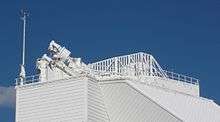
The third mirror of the main telescope which sends the light down into the observing room can be moved above three different positions. Two of these have a vacuum spectrograph beneath them, one of 18 meter deep and the other 4 meter deep with lower resolution but higher light throughput. These two spectrographs are able to rotate to compensate for the rotation of the image caused by the use of a heliostat. The third position can only be equipped with a static optical table with no image rotation correction and is therefore rarely used.
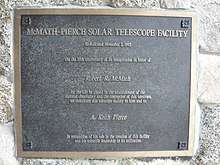
The auxiliary telescopes can only be used for imaging on static optical tables and do not provide image rotation correction.
NSF divestment and reinvestment
In 2016, the National Science Foundation (NSF) announced that it would be divesting from the McMath-Pierce solar observatory. The operator, known as National Solar Observatory, began accepting proposals from new potential operators. A concept for retrofitting by the Kitt Peak visitor center manager was first provided to the NSF for consideration in July 2017. That concept was ultimately developed into a funding proposal to the NSF, submitted again in May 2018. This proposal was awarded in September 2018 by the NSF to the Association of Universities for Research in Astronomy, the organization that operates Kitt Peak National Observatory on behalf of the NSF.[9][10]
See also
- List of solar telescopes
- Daniel K. Inouye Solar Telescope (Major new solar telescope project of the early 21st century)
References
- Beedle, Lynn S. (1982). "Fazlur Rahman Khan". Memorial Tributes. National Academies Press (National Academy of Engineering). 2–4: 152-157 (154).
- "The McMath-Pierce Solar Telescope". www.noao.edu. Retrieved 2019-10-13.
- Isbell, Douglas; Strom, Stephen E. (2016-12-15). Observatories of the Southwest: A Guide for Curious Skywatchers. University of Arizona Press. ISBN 9780816536689.
- Mace, Mikayla. "$4.5M science foundation grant latest in Kitt Peak telescope revitalization". Arizona Daily Star. Retrieved 2019-10-13.
- "McMath-Pierce Telescope and Instruments". National Solar Observatory. National Solar Observatory. Retrieved 28 March 2017.
- Keller, Christopher. "Low-Cost Solar Adaptive Optics". noao.edu. Archived from the original on 21 February 2016. Retrieved 14 May 2017.
- "McMath–Pierce Solar Telescope". Archived from the original on 2011-11-17. Retrieved 2012-03-16.
- "NSO/KP History of the MP Facility". Archived from the original on 2008-07-08. Retrieved 2008-05-16.
- "National Science Foundation to Fund New "Windows on the Universe" Astronomy Outreach Center at Kitt Peak National Observatory". National Optical Astronomy Observatory (Press release).
- Mace, Mikayla (27 September 2018). "$4.5M science foundation grant latest in Kitt Peak telescope revitalization". Arizona Daily Star.
External links

- Kitt Peak virtual tour: McMath–Pierce Solar Telescope
- "McMath Solar Telescope of the Kitt Peak National Observatory", A. K. Pierce, Applied Optics, 3, 1337–1346, 1964.
- A History of the McMath–Pierce
- Schematic diagram of the McMath–Pierce telescope
- Adaptive optics at the McMath–Pierce telescope